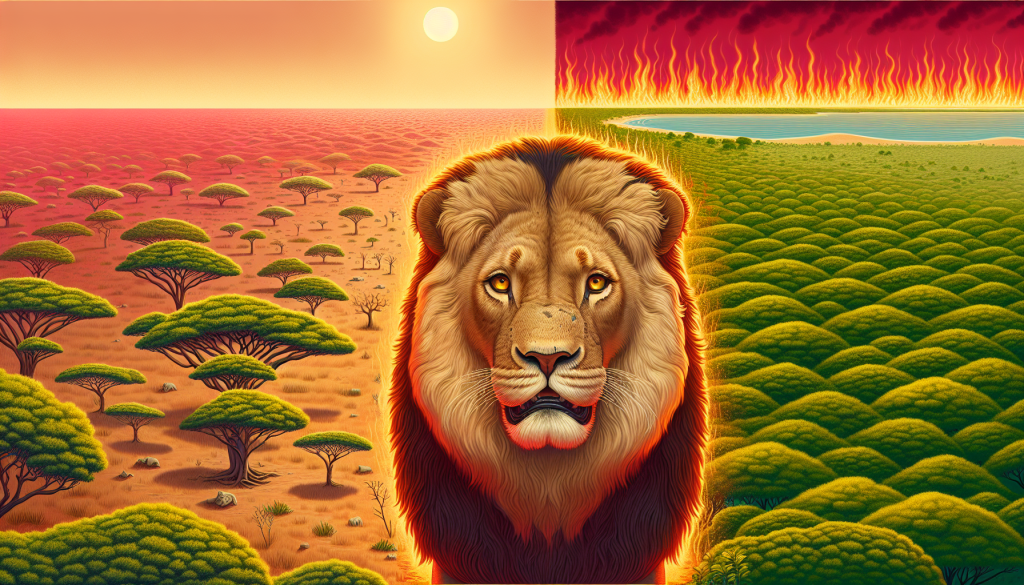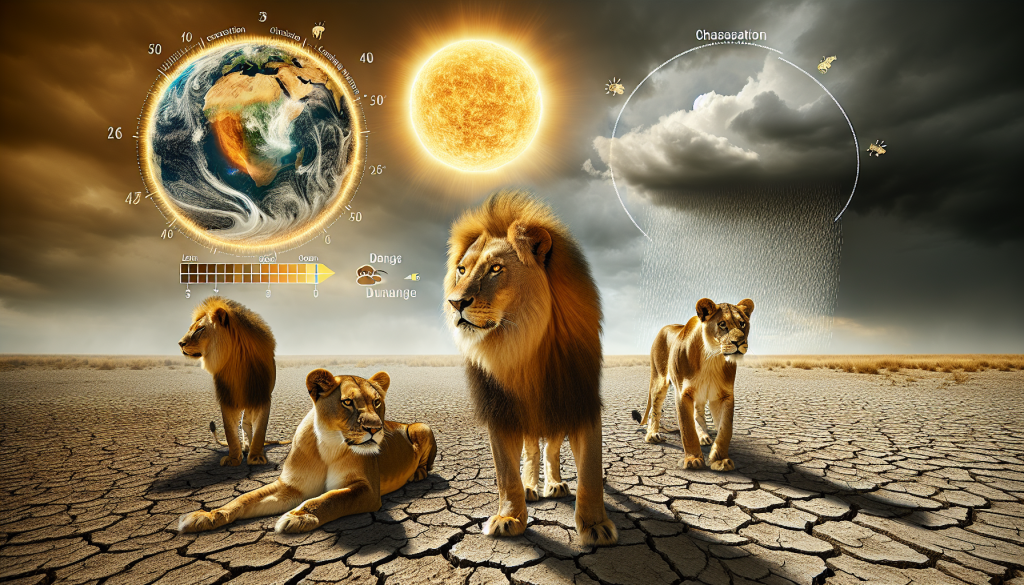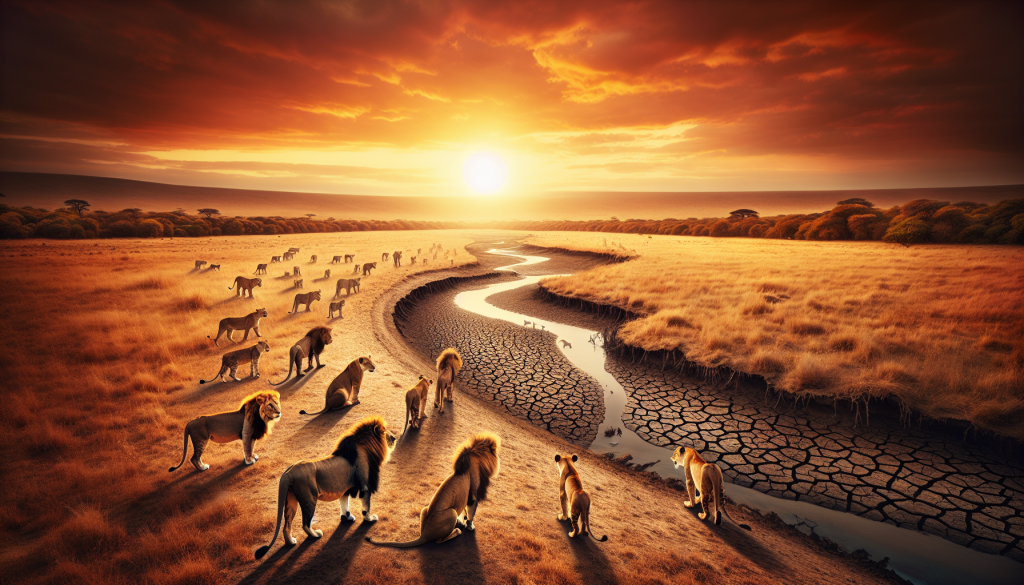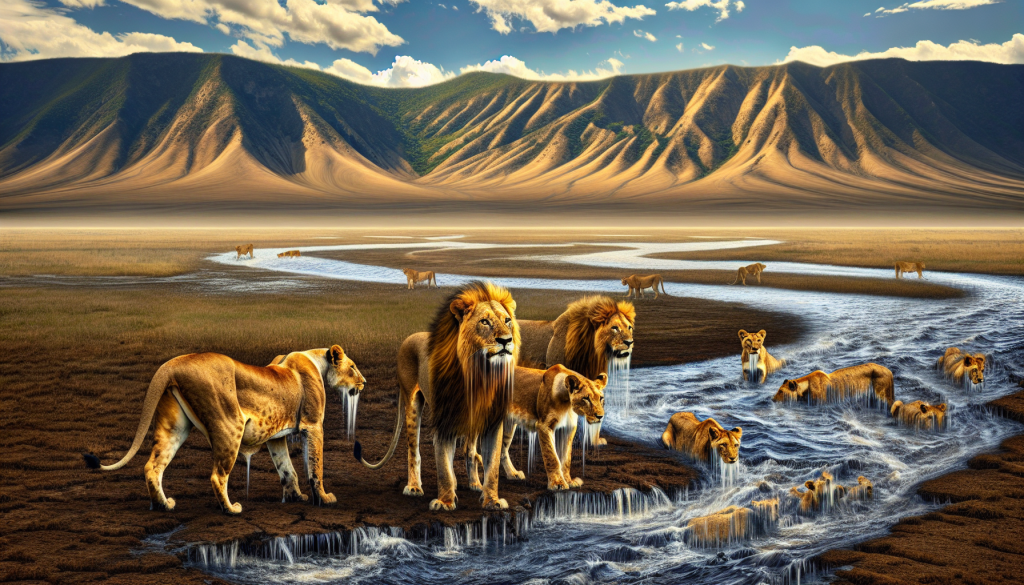Picture this: vast savannahs stretching out as far as the eye can see, the occasional acacia tree providing shade, and the unmistakable roar of a lion echoing through the air. The powerful presence of these majestic creatures has long captivated our imagination. However, as climate change continues to unfold, the very habitats that sustain lion populations are at risk. From changing weather patterns to decreasing prey availability, the impact of climate change on lion habitats is undeniable. In this article, we will explore the profound consequences of these changes, shedding light on the uncertain future that lions face in the face of a rapidly changing world.

Decreased Availability of Prey
Shifts in Prey Distribution
Climate change is causing shifts in the distribution of prey, which has a significant impact on lion habitats. As temperatures rise and ecosystems change, the distribution of prey species such as zebras, wildebeests, and antelopes is being altered. These changes are forcing lions to adapt and change their hunting behaviors. For example, certain prey may migrate to different areas to find suitable food sources, leaving lions to search for new hunting grounds. This shift in prey distribution can disrupt the balance of predator-prey relationships and decrease the availability of prey for lions.
Decreased Prey Population Size
In addition to shifts in prey distribution, climate change is also contributing to a decline in the population size of prey species. The increase in temperatures and changes in rainfall patterns affect the availability and quality of vegetation, ultimately impacting the size and health of herbivorous prey populations. With fewer herbivores available, lions face a shortage of prey and may struggle to find enough food to survive. This can have a cascading effect on the entire ecosystem, as the decline in prey populations can also impact other species that depend on these herbivores for food.
Increased Competition for Prey
With a decreased availability of prey due to climate change, lion populations are experiencing increased competition for limited resources. As the number of prey species declines, multiple lion prides and individuals are forced to compete for the remaining food. This heightened competition can lead to more aggressive interactions between lions and increased pressure on the available prey population. Ultimately, this can negatively impact the reproductive success and survival of lion populations, as individuals may not have access to enough food resources to thrive.
Loss of Suitable Hunting Grounds
Reduced Grassland Areas
Climate change is causing a reduction in grassland areas, which are essential hunting grounds for lions. Increasing temperatures and changing rainfall patterns can result in the drying out and degradation of grasslands, making them less suitable for the herbivores lions depend on for food. This loss of suitable grassland habitats directly affects the ability of lions to hunt effectively and reduce their chances of successful kills. In turn, this can lead to malnourishment and overall population declines among lion populations.
Loss of Water Sources
As climate change progresses, there is a significant risk of loss of water sources in lion habitats. Droughts and reduced rainfall can lead to the drying up of rivers, lakes, and other water bodies. This poses a major challenge for lions, as they rely on these water sources not only to quench their thirst but also to ambush and capture their prey. Without access to adequate water sources, lions are at a disadvantage, impacting their hunting success rates and overall survival.
Decline in Vegetation Density
Climate change also contributes to a decline in vegetation density, which can negatively impact lion habitats. Rising temperatures and changes in rainfall patterns can result in the loss of plant species or alterations in their growth patterns. This decline in vegetation density affects the availability of cover for both prey and predators, including lions. Reduced vegetation cover makes it harder for lions to stealthily approach their prey, reducing their hunting efficiency and success.
Increased Human-Wildlife Conflict
Livestock Predation
Climate change is exacerbating human-wildlife conflict, particularly in areas where lion habitats overlap with human settlements. As climate change forces prey to migrate or seek food in different areas, lions may be compelled to seek alternative food sources, such as livestock. This leads to conflicts between local communities who rely on their livestock for their livelihoods and lions in search of food. Livestock predation by lions can result in the loss of valuable livestock and economic hardship for the affected communities, further straining the relationship between humans and lions.
Crop Raiding
In addition to livestock predation, climate change is also causing lions to engage in crop raiding. As the availability of prey decreases, lions may turn to agricultural fields as a source of food. This puts them in direct conflict with farmers who depend on their crops for sustenance and income. Crop raiding by lions can result in significant crop losses, impacting the livelihoods and food security of farmers. Consequently, this can lead to retaliatory actions against lions and further escalate the human-wildlife conflict.
Retaliatory Killings
The increased human-wildlife conflict resulting from climate change has also led to an increase in retaliatory killings of lions. As conflicts escalate and tensions rise, local communities often resort to killing lions in an attempt to protect their livestock, crops, and lives. Retaliatory killings pose a grave threat to lion populations, as they can lead to the targeted killing of individual lions, which disrupts social structures within prides and can lead to a decline in overall population size.
Altered Migration Patterns
Influences of Temperature and Rainfall Changes
Climate change plays a significant role in altering the migration patterns of both prey and predator species, including lions. Changes in temperature and rainfall patterns can disrupt traditional migration routes and timings, as well as the availability of seasonal water and food sources. These alterations force lions to adapt and adjust their movement patterns in search of suitable prey, resulting in changes in migration behavior. Consequently, disruptions in migration can lead to a decrease in successful breeding opportunities, as well as increased competition and conflicts between lion populations.
Shifts in Seasonal Food Availability
The altered migration patterns caused by climate change also affect the seasonal availability of food for lions. As prey species migrate to new areas in search of suitable food sources, the timing and abundance of food change throughout the year. This poses challenges for lions, as they must adjust their hunting strategies and learn to adapt to these shifts in food availability. If lions are unable to capitalize on these changes, it can have negative consequences for their nutrition and reproductive success.
Disrupted Time of Breeding
Climate change-induced alterations in migration patterns and food availability also disrupt the timing of breeding for lions. The timing of breeding is often synchronized with the abundance of prey species and the availability of suitable conditions for raising young cubs. Disruptions in prey migration and seasonal food availability can impact the ability of lions to conceive, leading to delayed or unsuccessful mating. The consequences of disrupted breeding can have long-term effects on lion populations, potentially leading to a decline in their numbers.

Expanding Desertification
Encroachment of Arid Environments
Climate change is contributing to the expansion of arid environments, leading to the encroachment of deserts into areas once suitable for lion habitats. As rising temperatures and changing precipitation patterns transform previously habitable landscapes, desertification occurs at an accelerated rate. The expansion of deserts can lead to the loss of suitable habitats and the displacement of lion populations. The lack of vegetation and water resources in these arid environments poses significant challenges for lions, limiting their survival and reproduction capabilities.
Loss of Suitable Habitat
Alongside the encroachment of arid environments, climate change is causing the loss of suitable habitat for lions. The changing climate often results in the degradation or loss of vegetation, affecting the availability of cover, nesting sites, and hunting grounds for lions. The loss of suitable habitat reduces the overall carrying capacity of an area for lion populations, forcing them to migrate or compete for limited resources. Without access to suitable habitats, lions face increased vulnerability and a higher risk of population decline.
Reduced Access to Water
Expanding desertification due to climate change impacts the availability of water resources for both wildlife and human populations. As arid environments expand into formerly habitable areas, water sources become scarce or completely disappear. This lack of accessible water poses a significant challenge for lions, as they depend on regular access to water for their survival. Limited access to water leads to increased competition among lion populations, further straining their chances of survival and reproduction.
Increased Incidence of Diseases
Spread of Parasites
Climate change contributes to the spread and proliferation of parasites in lion habitats. Rising temperatures and changes in rainfall patterns create favorable conditions for parasites to thrive and spread. Parasites such as ticks, fleas, and mites can cause a range of health issues for lions, ranging from skin irritations to more severe diseases. The increase in parasite prevalence can weaken the overall health and immune systems of lion populations, making them more susceptible to other diseases and reducing their overall fitness.
Expansion of Infectious Diseases
The expansion of infectious diseases is another consequence of climate change in lion habitats. Changes in temperature and rainfall patterns can create conditions that allow diseases to flourish and spread among wildlife populations. Lions can be exposed to various infectious diseases, including those transmitted by other species or through contaminated water sources. The expansion of infectious diseases poses a significant threat to lion populations, as it can lead to increased mortality rates and a decline in overall population size.
Weakening of Immune Systems
Climate change-induced stressors, such as food scarcity, increased competition, and exposure to diseases, can collectively weaken the immune systems of lion populations. Constant challenges to their health and well-being, coupled with the presence of parasites and infectious diseases, can impair the ability of lions to fight off illnesses and infections. Weakened immune systems make lions more susceptible to both common and emerging diseases, posing a significant threat to the long-term survival of these iconic predators.

Threats from Extreme Weather Events
Floods and Droughts
Climate change intensifies the frequency and severity of extreme weather events, such as floods and droughts, which pose significant threats to lion habitats. Floods can result in the destruction of lion habitats, leading to displacement and potential population decline. Conversely, droughts can dry up water sources, reduce vegetation availability, and cause food scarcity, affecting lion populations’ ability to survive and reproduce. The increasing occurrence of extreme weather events further compromises the already vulnerable state of lion habitats.
Heatwaves and Wildfires
Heatwaves and wildfires are becoming more frequent and severe as a result of climate change, posing serious risks to lion habitats. Rising temperatures combined with prolonged periods of intense heat can lead to dehydration, heat stress, and even death among lion populations. Furthermore, the occurrence of wildfires can result in the loss of vegetation, reducing available cover and increasing the risks of direct harm to lions. Heatwaves and wildfires not only directly impact lion survival but can also disrupt ecosystems and decrease prey availability, exacerbating the challenges lions already face.
Storm Surges and Coastal Erosion
Coastal lion habitats are particularly vulnerable to storm surges and coastal erosion, both of which are exacerbated by climate change. Rising sea levels and more intense storms increase the risk of coastal flooding and erosion, damaging or destroying lion habitats near coastlines. The loss of coastal habitats limits the available territory for lion populations, increases their exposure to human settlements, and creates barriers to movement and gene flow. The impacts of storm surges and coastal erosion further contribute to the decline of lion populations in these areas.
Reduced Genetic Diversity
Limited Gene Flow
Climate change can restrict the movement of lion populations, leading to limited gene flow and reduced genetic diversity. Disruptions in migration patterns, loss of suitable habitats, and increased barriers to movement can isolate lion populations from one another. Limited gene flow restricts the exchange of genetic material among populations, reducing genetic diversity and increasing the risk of inbreeding depression. The loss of genetic diversity can compromise the adaptability and resilience of lion populations in the face of changing environmental conditions and other threats.
Inbreeding Depression
The limited gene flow resulting from climate change-induced habitat fragmentation and isolation increases the risk of inbreeding depression among lion populations. Inbreeding depression refers to the negative effects that occur when individuals with similar genetic backgrounds mate and produce offspring. The accumulation of harmful recessive genetic traits can reduce the overall health, reproductive success, and survival rates of lion populations. The increased occurrence of inbreeding depression threatens the long-term viability of lion populations and their ability to adapt to changing environmental conditions.
Increased Vulnerability to Diseases
Reduced genetic diversity resulting from limited gene flow makes lion populations more vulnerable to diseases. Genetic diversity plays a vital role in the ability of a population to withstand and combat various diseases and pathogens. With reduced genetic diversity, lion populations may lack the genetic variation necessary to mount effective immune responses to new or emerging diseases. As a result, lions with reduced genetic diversity are at a higher risk of being disproportionately affected by infectious diseases, further endangering their survival.

Disruption of Social Structures
Increased Male-Male Competition
The disruption of social structures within lion populations is a significant consequence of climate change. Increased competition for limited resources, such as food and water, can intensify intra-species competition, particularly among male lions. As resources become scarcer, male-male competition for dominance and access to mates becomes more intense. This can lead to increased aggression and conflicts within lion prides as males vie for control and reproductive opportunities. The disruption of social structures can affect the stability and overall reproductive success of lion populations.
Reduced Cohesion within Pride
Climate change-related stressors and changes in resource availability can lead to reduced cohesion within lion prides. As lions experience food scarcity and increased competition, the bonds between pride members can weaken. The destabilization of pride cohesion can result in increased infighting, social fragmentation, and even the splintering of prides. A lack of strong social cohesion within prides can negatively impact breeding success and survival, making it more difficult for lion populations to recover and adapt to changing environmental conditions.
Impacts on Reproductive Success
The disruption of social structures within lion populations resulting from climate change can significantly impact reproductive success. In times of resource scarcity and increased competition, the reproductive success of lions can decline. The increased aggression during male-male competition for access to mates can cause physical injuries, reduce successful mating opportunities, and lead to the exclusion of certain individuals from breeding. The reduced reproductive success, along with other stressors induced by climate change, poses a significant threat to the long-term viability of lion populations.
Impacts on Lion Populations
Declining Population Size
The combined effects of climate change on lion habitats result in declining population sizes. The loss of suitable hunting grounds, reduced prey availability, increased human-wildlife conflict, and other climate-induced stressors have a cascading effect on lion populations. Habitat degradation, limited access to water, disease outbreaks, and a decline in reproductive success contribute to decreased lion population sizes. The declining numbers pose a significant risk of local extinctions and decrease the species’ overall resilience and ability to adapt to future changes.
Fragmentation of Habitat
Climate change-induced alterations to lion habitats result in the fragmentation of their populations. The loss of suitable habitats, encroachment of arid environments, and barriers to movement disrupt the connectivity and continuity of lion habitats. Fragmentation reduces the ability of lion populations to interact, exchange genetic material, and maintain long-term viability. The fragmentation of habitats further exacerbates the challenges faced by lions, increasing isolation, reducing the available territory, and limiting their ability to respond and adapt to changing environmental conditions.
Potential Local Extinctions
As a result of the multiple impacts of climate change on lion habitats, the potential for local extinctions becomes a significant concern. The combination of habitat loss, decreased prey availability, increased human-wildlife conflict, reduced genetic diversity, and other stressors can push lion populations to the brink of extinction in localized areas. Once a population reaches a critically low number, it becomes increasingly vulnerable to further decline and unable to sustain itself. The potential for local extinctions highlights the urgent need for conservation efforts aimed at mitigating the impacts of climate change and protecting these iconic animals.

